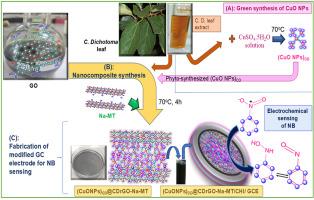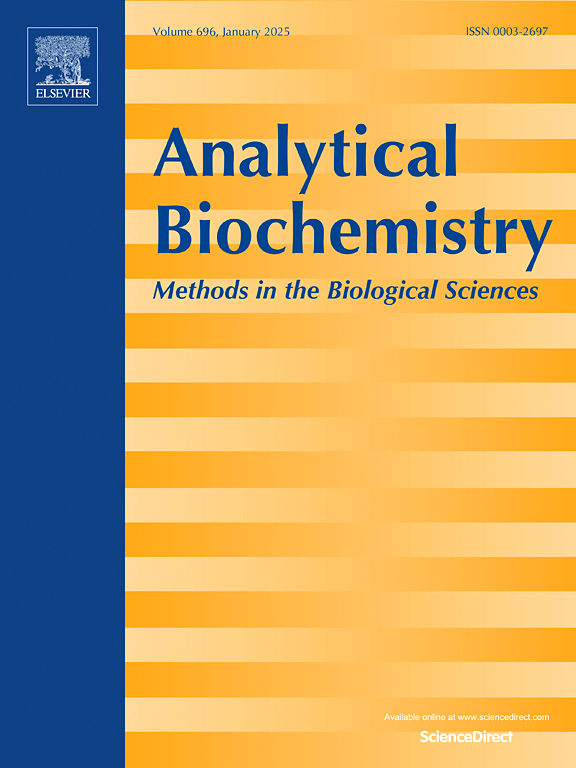生物合成还原氧化石墨烯/CuO基纳米复合材料,使用“Cordia dichotoma”叶提取物测定“硝基苯”
IF 2.5
4区 生物学
Q2 BIOCHEMICAL RESEARCH METHODS
引用次数: 0
摘要
本研究中,植物辅助合成氧化铜纳米颗粒(CuO NPs)CD和还原性氧化石墨烯(CDrGO)分别使用“Cordia dichotoma”植物的叶提取物进行,并将它们与电化学活性导电粘土“钠蒙脱土(Na-MT)”相结合,合成了一种新的纳米复合材料“(CuO NPs)CD@CDrGO-Na-MT”。CDrGO对(CuO NPs)CD和Na-MT的协同作用在较低电位下增强了有害的“硝基苯(NB)”的电化学还原。采用表征技术、透射电子显微镜(TEM)、傅里叶变换红外光谱(FTIR)、x射线衍射(XRD)和x射线光电子能谱(XPS)对所制备的三元纳米复合材料进行了表征。采用循环伏安法和差分脉冲伏安法分别考察了硝基苯的电化学性能和电化学还原性能。在0.016 ~ 360 μM和360 ~ 6980 μM的宽线性范围内记录了NB的电还原,检测限为15 nM,干扰影响可以忽略不计。本文章由计算机程序翻译,如有差异,请以英文原文为准。

Biosynthesised reduced graphene oxide/CuO based nanocomposite using ‘Cordia dichotoma’ leaf extract for ‘nitrobenzene’ determination
Herein, plant-assisted synthesis of copper oxide nanoparticles (CuO NPs)CD and reduced graphene oxide (CDrGO) was performed individually using the leaf extract of ‘Cordia dichotoma’ plant and they were associated with electrochemically active conducting clay ‘Sodium-Montmorillonite (Na-MT)’ leading to the synthesis of a new nanocomposite named ‘(CuO NPs)CD@CDrGO-Na-MT’. The collaboration of CDrGO paired (CuO NPs)CD and Na-MT enhanced the electrochemical reduction of noxious ‘Nitrobenzene (NB)’ at a lower potential. The prepared ternary nanocomposite was confirmed with characterisation techniques, Transmission electron microscopy (TEM), Fourier transform infrared (FTIR) spectroscopy, X-ray diffraction (XRD) and X-ray photoelectron spectroscopy (XPS). Electrochemical properties and electrochemical reduction of ‘Nitrobenzene’ were inspected with cyclic voltammetry and differential pulse voltammetry techniques, respectively. The electro-reduction of NB was recorded in two wide linear ranges of 0.016–360 μM and 360–6980 μM with a detection limit of 15 nM and negligible effect of interferences.
求助全文
通过发布文献求助,成功后即可免费获取论文全文。
去求助
来源期刊

Analytical biochemistry
生物-分析化学
CiteScore
5.70
自引率
0.00%
发文量
283
审稿时长
44 days
期刊介绍:
The journal''s title Analytical Biochemistry: Methods in the Biological Sciences declares its broad scope: methods for the basic biological sciences that include biochemistry, molecular genetics, cell biology, proteomics, immunology, bioinformatics and wherever the frontiers of research take the field.
The emphasis is on methods from the strictly analytical to the more preparative that would include novel approaches to protein purification as well as improvements in cell and organ culture. The actual techniques are equally inclusive ranging from aptamers to zymology.
The journal has been particularly active in:
-Analytical techniques for biological molecules-
Aptamer selection and utilization-
Biosensors-
Chromatography-
Cloning, sequencing and mutagenesis-
Electrochemical methods-
Electrophoresis-
Enzyme characterization methods-
Immunological approaches-
Mass spectrometry of proteins and nucleic acids-
Metabolomics-
Nano level techniques-
Optical spectroscopy in all its forms.
The journal is reluctant to include most drug and strictly clinical studies as there are more suitable publication platforms for these types of papers.
 求助内容:
求助内容: 应助结果提醒方式:
应助结果提醒方式:


